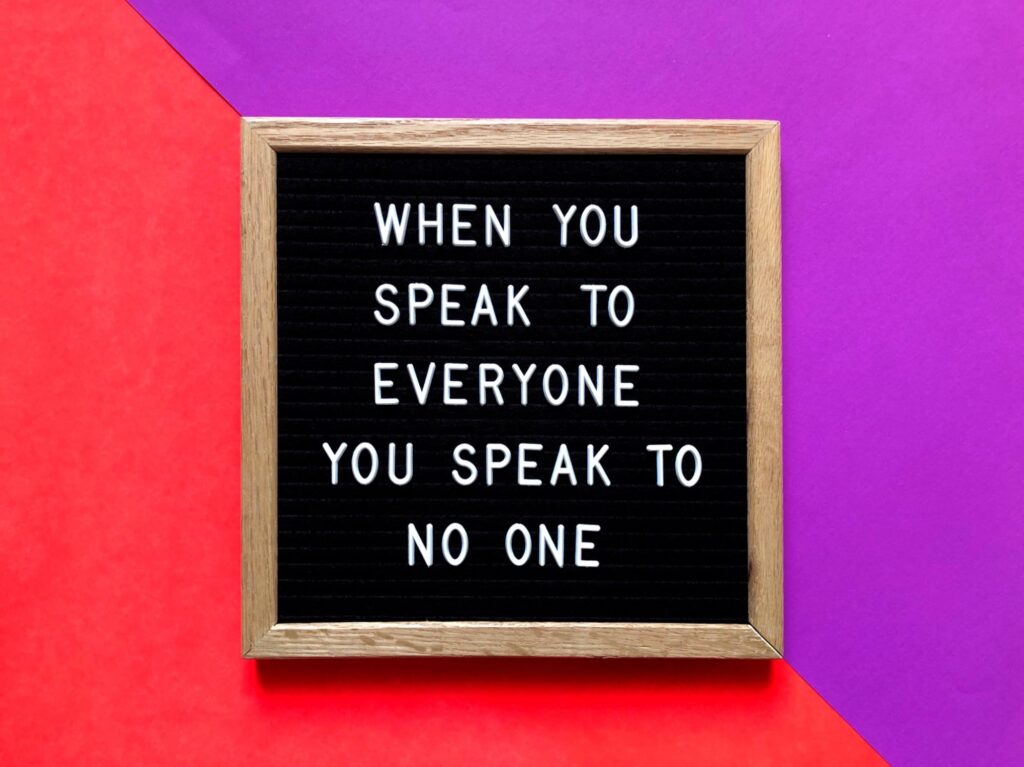Outbound (also known as cold email) email marketing is when an organization contacts another organization without prior permission. These individuals…
Outbound (also known as cold email) email marketing is when an organization contacts another organization without prior permission. These individuals have not signed up to receive information and may have never heard of your organization.

Traditional methods of outbound marketing (aka interruption marketing) methods include direct mail, radio ads, cold calling, event sponsorships, and billboards. You probably have a negative opinion of a majority of these advertising methods.
Some US adults may be boycotting social media, but it’s almost impossible to not check your email in the business world.
According to Venturebeat, email drives the highest ROI for marketers.
It’s easy to send email in mass with the aid of technology.
Email is 40x more effective at reaching targeted new customers than social media.
B2B outbound outreach is alive and well in the age of increased data privacy regulation.
But we have a few suggestions for this new age of cold outreach.
Be even more selective outreach. That means having a clear reason to contact a lead based on your team’s research.
Only collect personal data that is needed for your outreach and deleting the data when you end outreach.
Be prepared to answer questions about data collection. If you’re not comfortable disclosing how you gathered their data, you should rethink how your organization collects data for lead generation.
Just like traditional outbound marketing, you probably have a negative opinion of outbound email outreach. Outbound email is the digital equivalent of a cold call that can be sent with ease and little to no repercussions to the sender. Organizations that used “spray and pray” tactics and purchased email lists created this reputation.
Outbound email marketing is often used by sales-driven B2B organizations. It’s common for these organizations to have large teams of sales development representatives with email quotas. These email quotas contribute to employees sending a high volume of half-baked emails. With cold outreach automation software (Outreach.io, Woodpecker.co, etc.) organizations can send email in mass quickly and easily.
Outbound email marketing starts with segmentation and targeting based on research. If you’re not targeting the right person at the right company, it doesn’t matter how well-written your email is or how many emails you send. Your cold outreach will only be well received if you do the leg work before hitting send.
If you’re an organization with existing customers, you know what your ideal customer looks like.
For example, a SAAS company that creates shopping cart software would want to reach out to online retailers. Your organization has noticed that your software works especially well for shoe retailers. And based on your conversations with current clients they often had issues with Competitor A’s software. So you can drill down that your ideal client is an online shoe retailer that currently uses Competitor A.
Once you have your ideal company defined, you need to also define what person at the company you need to contact. This person must work in the right area of the company and be a decision-maker (or have enough influence over the decision-maker) to move the buying process forward.
Organizations vary in structure, but the role you need to contact within companies will be similar. Start by reviewing past successful sales interactions. Who did you talk to? Once you’ve answered that question, write down their names and research what their job titles were at the time you interacted with them. It’s important to get their job title at the time of the transaction because individuals who are trusted to make decisions often change roles. You can find their role at the time by either going through past email communications (take a peek at their email signatures) or find them on LinkedIn (look at their experience section).
After you do this research, you will have a list of job titles. If there is a single job title or a few that have multiple occurrences, then you have the job title to target. However, a lot of times (especially in tech) similar job roles in different companies have seemingly unrelated names. In this case, it’s useful to make a list of keywords for your sales team to identify individuals whose job duties match the ideal target.
Now you’re ready to move from building an ideal client profile to finding that individual in real life.
Say you have identified “e-commerce director” as a job role you consistently work with and Nike as an ideal client.
To find the person with this title simply log in to LinkedIn and search using the criteria in the image below.
In some instances, the individual will not have a LinkedIn account or they rarely use their account. In this case, LinkedIn is of limited use. But in cases where they are active on LinkedIn, it’s a great place to start your cold outreach and continue researching your lead.
We mentioned earlier that there isn’t always a clear job title to search and recommended creating a list of keywords. For example, if you wanted to reach out to someone on Nike’s e-commerce team “ecommerce” would be an excellent keyword to search.
In the image above you can see how you can easily search for individuals at Nike with e-commerce in their title.
Now that you have the name of your ideal contact at your ideal company, you have to find their email address.
It’s obvious why Jeff Bezos and Elon Musk don’t make it easy to contact them by email. If their email was easily available, everyone and their cousin would inundate them with business pitches and Nigerian princes would spam them to no end.
Your organization likely isn’t trying to reach someone that high profile, but the same principle applies to lower-level decision-makers. These decision-makers safeguard their email address to protect their inboxes from unsolicited emails.
So how do you find the email addresses of potential customers? Email lookup tools (LeadFuze, Hunter.io, etc.) are the most popular and efficient method available to marketers attempting to find the email address of potential prospects. These tools aren’t foolproof, but they are great to have in your toolbox.

B2B outbound outreach is alive and well in the age of increased data privacy regulation.
But we have a few suggestions for this new age of cold outreach.
Be even more selective outreach. That means having a clear reason to contact a lead based on your team’s research.
Only collect personal data that is needed for your outreach and deleting the data when you end outreach.
Be prepared to answer questions about data collection. If you’re not comfortable disclosing how you gathered their data, you should rethink how your organization collects data for lead generation.

Personalized email in this context means more than just including “Hi, First Name,” at the beginning of your email. It means using what you uncovered in your research to frame your value proposition for the prospective customer you’re contacting.
You want your email to seem as close to one on one communication as possible.
This is your opportunity to establish rapport with the customer by showing you have done the leg work. You must prove to them that you understand their industry, company, and, most importantly, their problem. You must also prove that your solution has helped solve the problem for a company like theirs.
Additionally, make your email stand out by mentioning something the prospective client is working on. This could be a YouTube video, blog post, podcast, or anything else they might be proud of.
Personalization will also help your outreach get past spam filters. You can quickly find hundreds of templates for cold emails using a Google search, and you should never use them. You aren’t the only one who has googled it, and others are sending those messages with very little variation.
The same sales email sent to hundreds or thousands of people makes it easy for spam filters to detect. Sending templated but unique messages to prospects decreases your chances of landing in the spam folder.
A single perfect cold email doesn’t exist, but here are some principles of an effective outbound email:
Personalization – Definitely #1. Do NOT let your sales team kick off an email sequence by sending an email that has not been tailored for the prospect.
Forget Templates – Finding your style will get you much further than squeezing your message into a template that has been used thousands of times.
Stand-out with Subject Lines – Whether writing an inbound or outbound email, your subject line shouldn’t be an afterthought. 47% of email recipients open an email because of the subject line.
Clear CTA – There should be a single call to action that’s easy to find and act upon. Whether you’re setting up an in-person meeting, zoom call, or phone call, make it easy for your prospect to book an appointment.
Sidenote for salespeople who hate writing: technology is here to save the day (unless you also have stage fright)! An alternative to writing cold outreach is recording a video or audio message for a prospect. Sending personalized video content is sure to make you stand out. According to Martech Advisor, including video content in your email marketing can boost click rates by up to 300%! Popular tech solutions for embedding personalized video into sales emails include BombBomb and VidYard.
Persistence is an important part of any sales strategy. Salespeople must be able to handle objections and rejection. That being said, 44% of salespeople don’t make a second attempt to reach out after their first outreach is ignored. For a cold email campaign, rejection often comes in the form of an unanswered email. But just like with in-person sales, initial rejection doesn’t have to end the conversation.
That doesn’t mean more messages are always better. You don’t want to seem like your outreach is automated, pushy, or flat-out annoying. According to a study by Woodpecker.co, email sequences with 4-7 emails are 3x as likely to earn responses as an email sequence with 1-3 emails.
An outbound email sequence is set up and functions the same way as an inbound marketing sequence.
The above image shows a condition-based email sequence created in ActiveCampaign.
That being said you will likely need to invest in a different software solution if cold email is going to be a large part of your sales strategy. Due to increased data privacy regulations, US-based email marketing software like ActiveCampaign, Campaign Monitor, and MailChimp only allow emails to be sent to email subscribers. These changes were made despite cold email being legal and alive and well post-GDPR.
Luckily, other software solutions have come onto the market to help organizations reach prospective customers who haven’t subscribed. These sales engagement platforms include Outreach.io, Woodpecker.co, and more.
These tools also allow you to build condition-based email sequences based on factors like the time between responses, email opens, email clicks, etc. . Another advantage is the ability to set up advanced tracking features.
If you’re unable to invest in one of these solutions or you only have a few accounts to reach out to, you can attempt to reach potential customers by sending an email through your email service provider. The problem with sending sales outreach through your ESP is the lack of scalability.
Automotive groups (ex. Hendrick Automotive Group) and software companies (ex. Salesforce) are two industries that often employ large Sales/Business Development Representative teams to reach out to prospects.
Often the success of an outbound strategy comes down to scalability. But scale is relative. Most small businesses don’t need Salesforce’s regiment of SDRs. That being said if you have a small team you will need to provide them with tools to make their work scalable.
For lesser-known companies, we suggest running an awareness campaign previous to or in conjunction with cold outreach campaigns. For some reason, brand awareness is often overlooked as an element of cold outreach. Creating awareness will make leads more receptive to your outreach, especially when they’re in an active research phase.
Copyright © 2017-2025 · Carbon Digital · All Rights Reserved.